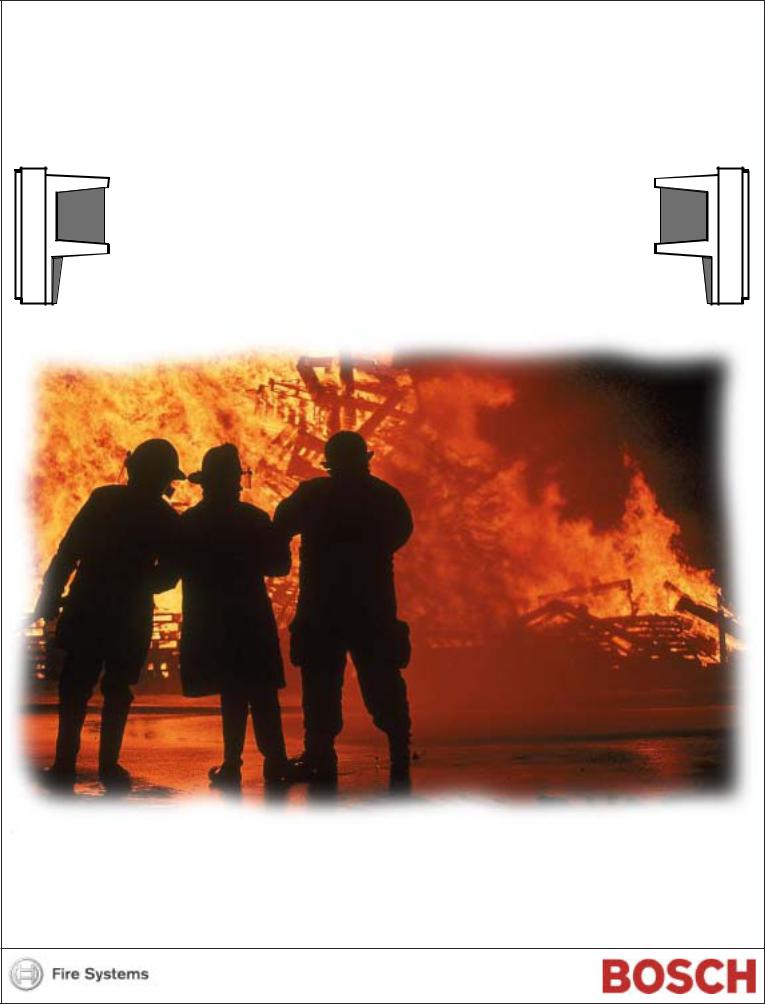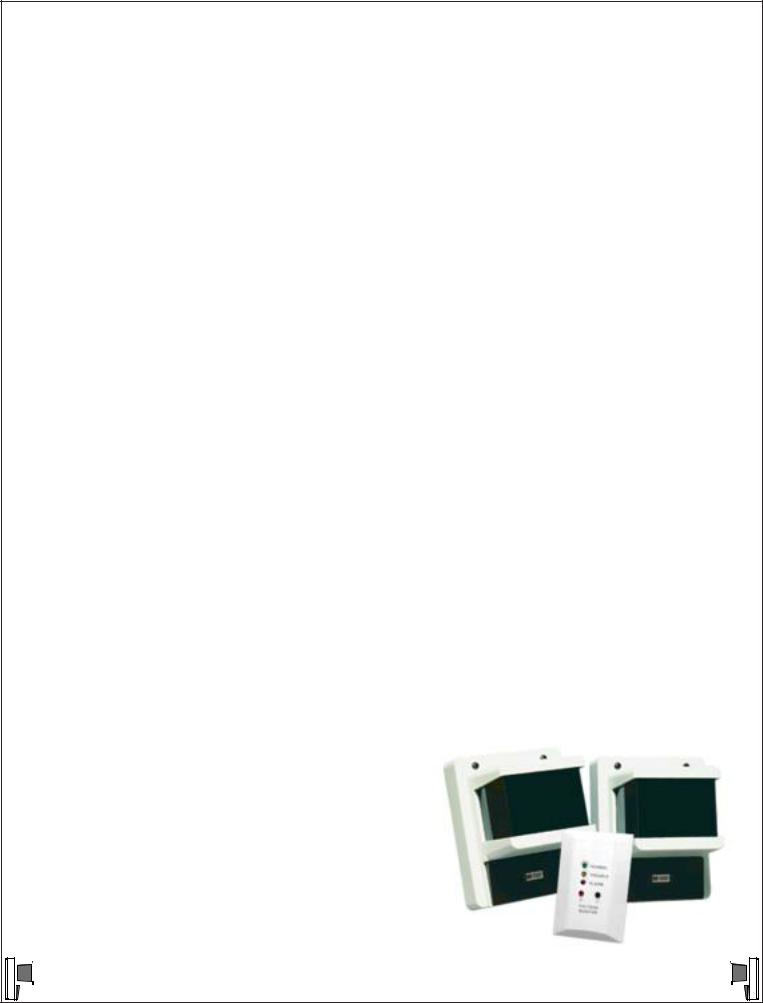Bosch D296, D297 User Manual

D296/D297 Series
Projected Beam
Smoke Detectors
Application Guide

Contents
1.0 |
Scope |
--------------------------------------------------------------- |
|
3 |
2.0 |
Glossary of Terms ------------------------------------------------ |
3 |
||
3.0 |
Introduction -------------------------------------------------------- |
|
4 |
|
4.0 |
Specifications |
----------------------------------------------------- |
5 |
|
5.0 |
Accessories ------------------------------------------------------- |
|
4 |
|
6.0 |
Applications ------------------------------------------------------- |
|
6 |
|
|
6.1 |
Coverage --------------------------------------------------- |
6 |
|
|
6.2 |
Stratification ----------------------------------------------- |
6 |
|
|
6.3 |
Environmental Considerations ------------------------ |
7 |
|
|
|
6.3.1 |
Outdoor ------------------------------------------ |
7 |
|
|
6.3.2 |
Indoor--------------------------------------------- |
7 |
|
6.4 |
Mounting --------------------------------------------------- |
7 |
|
|
6.5 |
Location and Spacing----------------------------------- |
8 |
|
|
6.6 |
Ceilings ---------------------------------------------------- |
8 |
|
|
|
6.6.1 |
Flat Ceilings ------------------------------------ |
8 |
|
|
6.6.2 |
Sloped Ceilings -------------------------------- |
9 |
|
|
6.6.3 |
Peaked Ceilings ------------------------------- |
10 |
|
|
6.6.3 |
Long Ceilings ----------------------------------- |
10 |
7.0 |
Worksheet --------------------------------------------------------- |
|
11 |
|
2 |
D296/D297 Series Application Guide |

1.0Scope
This application guide is intended to assist in determining the best locations and applications of the D296 Series Long Range Beam Smoke Detectors.
This application guide contains information from the National Fire Protection Association standard NFPA-72, the National Fire Alarm Code, on automatic fire detectors and discusses the general application rules for the D296 Series.
Your Local Authority Having Jurisdiction (AHJ) should always be consulted before beginning the installation of any fire alarm system.
2.0Glossary of Terms
Beam Smoke Detector (Projected Beam Smoke Detector)
A device which senses smoke or smoke and heat by projecting a light beam from a transmitter across the protected area to a receiver that monitors the light signal.
Smoke and/or heat entering the beam path will decrease the light signal causing an alarm.
Detector Coverage
The area in which a smoke detector or heat detector is considered to effectively sense smoke and/or heat. This area is limited by applicable listings and codes.
Listed
The inclusion of a device in a list published by a recognized testing organization, indicating that the device has been successfully tested to meet the accepted standards.
Obscuration
The reduction of the ability of light to travel from one point to another due to the presence of solids, liquids, gases, or aerosols.
Receiver
The device, in a projected beam smoke detector system, which monitors the signal level of the light which is sent by the transmitter.
Sensitivity
The ability of a smoke detector to respond to a given level of smoke.
Smoke
The solid and gaseous airborne products of combustion.
Spot-Type Detector
A device which senses smoke and/or heat at its location only. Spot-type detectors have a defined area of coverage.
Stratification
The effect which occurs when smoke, which is hotter than the surrounding
air, rises until equal to the temperature of the surrounding air, causing the smoke to stop rising.
Transmitter
The device in a projected beam smoke detector which projects the light across the protected area to its associated receiver.
Trouble Condition
The status of a device or system which impairs its proper operation, i.e.,
open circuit on an initiation loop. The notification of a trouble condition indicated on a control panel or annunciator is a “TROUBLE” SIGNAL.
NFPA 72® , National Fire Alarm Code® are registered trademarks of the National Fire Protection Association.
D296/D297 Series Application Guide |
3 |

3.0Introduction
Why should I use Beam Smoke Detectors and where should I use them?
•Where there are high ceilings such as in atriums and aircraft hangers. Because the detectors mount on the walls easier access is achieved.
•Where there is a dusty environment such as in warehouses, factories and barns. The detectors have built-in compensation to prevent alarms due to dust.
•Where there are expansive ceilings. One set of beam smoke detectors can replace up to 24 spot type smoke detectors. This saves on service and installation costs especially is such areas as large offices or department stores.
•On ornamental ceilings where spot detectors would be a distraction.
•Where there is limited access to the ceiling such as in factories and warehouses.
The D296 Series are Long Range Projected Beam smoke detectors which consist of separate transmitters and receivers. The projected beam smoke detectors consist of a transmitter that projects an infrared beam across the protected area to a receiver containing a photosensitive cell, which monitors the signal strength of the light beam. The detector works on the principle of light obscuration. The photosensitive element of the beam smoke detector sees light produced by the receiver in a normal condition. The receiver is calibrated to a preset sensitivity level based on a percentage of total obscuration. This sensitivity level is determined by the length of the beam (the distance between the transmitter and receiver) and the desired response time. Eight sensitivity settings are available for selection by the installer based on the length of the beam used in a given application.
The transmitter may be powered independently from the receiver, which can greatly reduce wiring runs and, therefore, installation cost. Since battery back up is required for fire alarm systems, battery back up would be required for the transmitter whether it is powered from the panel or independently.
Unlike spot type photoelectronic smoke detectors, beam smoke detectors are generally less response sensitive to the color of smoke. Therefore, a beam smoke detector may be well suited to applications unsuitable for spot-type photoelectronic detectors, such as applications where the anticipated fire would produce black smoke. Beam smoke detectors do require visible smoke and therefore may not be as sensitive as ion detectors in some applications.
Beam smoke detectors are sensitive to the cumulative obscuration presented by a smoke field. This cumulative obscuration is created by a combination of smoke density and the linear distance of the smoke field across the projected light beam. Cumulative obscuration, then, is a measure of the percentage of light blockage.
Since the sudden and total obscuration of the light beam is not a typical smoke signature, the detector will see this as a trouble condition, not an alarm. This threshold is at a sensitivity level which exceeds 90 to 95% total obscuration. This minimizes the possibility of an unwanted alarm due to the blockage of the beam by a solid object, such as a sign or ladder, being inadvertently placed in the beam path.
Very small, slow changes in the quality of the light source also are not typical of a smoke signature. These changes may occur because of environmental conditions such as dust and dirt accumulation on the transmitter and/or receiver’s optical assemblies. These changes are typically compensated for by the automatic environmental compensation circuit. When the detector is first turned on and put through its setup program, it assumes the light signal level at that time as a reference point for a normal condition. As the quality of the light signal degrades over time, perhaps due to dust, the environmental compensation circuit will compensate for this change. The rate of compensation is limited to insure that the detector will still be sensitive to slow or smoldering fires. When the automatic environmental compensation circuit can no longer compensate for the loss of signal (as with an excessive accumulation of dirt) the detector will signal a trouble condition.
The receiver indicates a trouble condition if the the beam strength is increased by more than 20%. This can be caused by incorrect alignment of the transmitter and receiver or a partially blocked beam when the transmitter and receiver are installed.
4 |
D296/D297 Series Application Guide |
